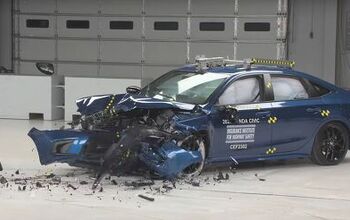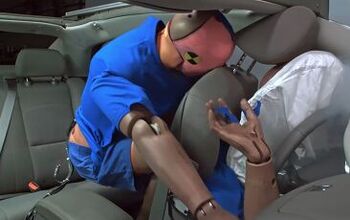IIHS Grouses About Passenger Safety in Rear Seats

The crash test dummies at the Insurance Institute for Highway Safety (IIHS) have been doing great work in ratcheting up the difficulty of their impact examinations, often requiring automakers to return to their drawing boards in search of the elusive Top Safety Pick+ designation. Now, the group is increasingly casting an eye toward how backseat passengers fare in a wreck.
According to a study released yesterday by the IIHS, several popular SUVs in the midsize category offer inadequate front crash protection for folks perched in rear seats. These findings were uncovered after the group tweaked their longstanding moderate overlap front crash test by installing a second dummy in the seat behind the driver. Although the test still includes a driver dummy, the IIHS is also now taking notice of rear passenger protection, making that metric a key differentiator of vehicles in this test.
“All these vehicles provide excellent protection for the driver,” said IIHS President David Harkey, “but only a handful extend that level of safety to the back seat.”
Of a baker’s dozen midsize SUVs tested, only a quartet - Ford Explorer, Ford Mustang Mach-E, Subaru Ascent, and Tesla Model Y - earn Good ratings.
A trio of others - Chevy Traverse, Toyota Highlander, and Volkswagen Atlas - scored a Marginal ranking while six more - Honda Pilot, Hyundai Palisade, Jeep Grand Cherokee, Jeep Wrangler 4-door, Mazda CX-9, and Nissan Murano - were rated Poor.
At issue? Measurements recorded by sensors in the second-row dummy, which is sized like a typical 12-year-old youngster, must not indicate an excessive risk of injury to the head, neck, chest, abdomen, or thigh. Video footage and greasepaint applied to the dummy’s head needs to confirm the restraints prevented its head from hitting the vehicle interior or coming too close to the front seatback, while an eye is kept on the dummy’s risk of “submarining,” which refers to sliding forward beneath the seat belt in a crash. I’ve learned a new word today.
In vehicles rated Poor, sensors indicated a high risk of head or neck injuries to the backseat passenger in all but the Wrangler. That model, lacking a side curtain airbag in the rear, was deemed to pose a significant risk for those injuries. In that Jeep, the lap belt also moved from its ideal position, from the pelvis to the abdomen.
As for these rigs in terms of the moderate overlap test’s original criteria for front seat occupants, there were some odd findings. In the Traverse, the driver dummy’s head hit the steering wheel hard through the airbag, which is a scary notion. And terrifyingly, according to the IIHS report, the driver’s side airbag did not deploy at all in the Wrangler.
[Image: IIHS]
Become a TTAC insider. Get the latest news, features, TTAC takes, and everything else that gets to the truth about cars first by subscribing to our newsletter.

Matthew buys, sells, fixes, & races cars. As a human index of auto & auction knowledge, he is fond of making money and offering loud opinions.
More by Matthew Guy
Latest Car Reviews
Read moreLatest Product Reviews
Read moreRecent Comments
- Probert They already have hybrids, but these won't ever be them as they are built on the modular E-GMP skateboard.
- Justin You guys still looking for that sportbak? I just saw one on the Facebook marketplace in Arizona
- 28-Cars-Later I cannot remember what happens now, but there are whiteblocks in this period which develop a "tick" like sound which indicates they are toast (maybe head gasket?). Ten or so years ago I looked at an '03 or '04 S60 (I forget why) and I brought my Volvo indy along to tell me if it was worth my time - it ticked and that's when I learned this. This XC90 is probably worth about $300 as it sits, not kidding, and it will cost you conservatively $2500 for an engine swap (all the ones I see on car-part.com have north of 130K miles starting at $1,100 and that's not including freight to a shop, shop labor, other internals to do such as timing belt while engine out etc).
- 28-Cars-Later Ford reported it lost $132,000 for each of its 10,000 electric vehicles sold in the first quarter of 2024, according to CNN. The sales were down 20 percent from the first quarter of 2023 and would “drag down earnings for the company overall.”The losses include “hundreds of millions being spent on research and development of the next generation of EVs for Ford. Those investments are years away from paying off.” [if they ever are recouped] Ford is the only major carmaker breaking out EV numbers by themselves. But other marques likely suffer similar losses. https://www.zerohedge.com/political/fords-120000-loss-vehicle-shows-california-ev-goals-are-impossible Given these facts, how did Tesla ever produce anything in volume let alone profit?
- AZFelix Let's forego all of this dilly-dallying with autonomous cars and cut right to the chase and the only real solution.



































Comments
Join the conversation
I wonder how long it will take them to come up with the idea of putting a dummy in the third row.
This company arbitrarily designs new tests to make sure they can whine about something.